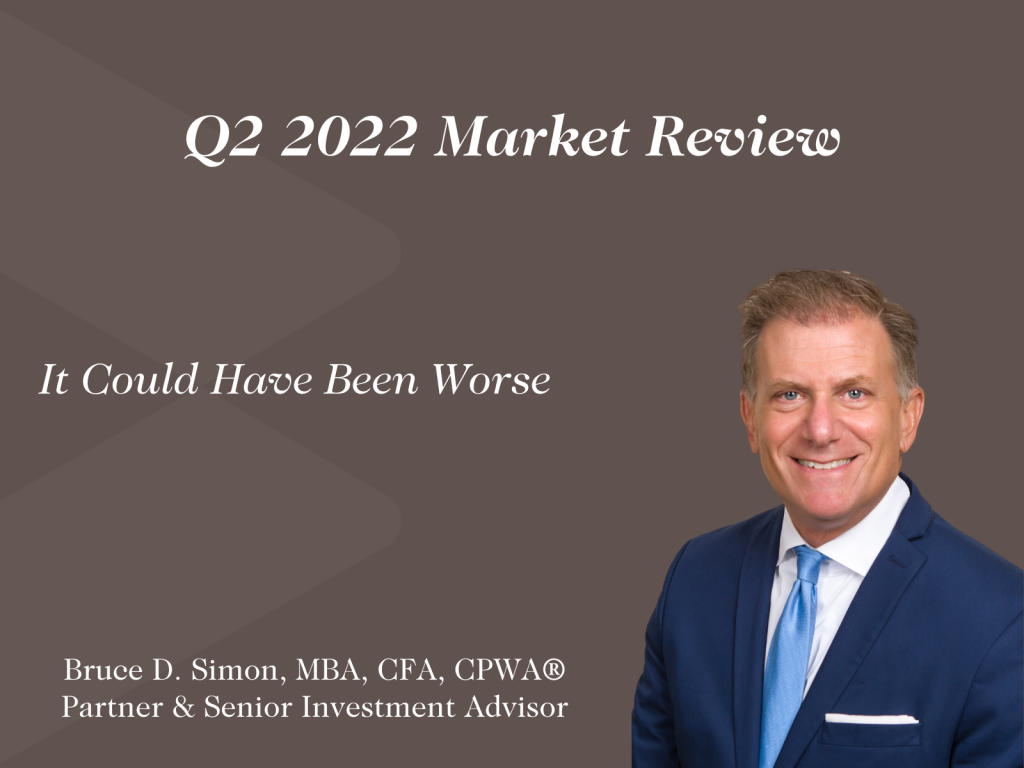Market Recap
Picture this: three straight years of strong equity market returns leading to very high valuations. US inflation pushing 8% with little relief in sight. Market participants, convinced that the Federal Reserve was too lax in addressing the inflation problem, ratcheting up their expectations for interest rate hikes from 4 at the start of the quarter to 9 by its end. An inverted yield curve, a reasonably reliable harbinger of recession, appearing late in the quarter. And then, in late February, a war that threatens the geopolitical stability in place since World War II.
With those facts in hand, a rational investor might have expected a sharp selloff in equity markets in the first quarter. Yet the S&P 500 fell only 4.6%, including a 3.6% gain in March. In part because of its relative isolation from the direct impact of the Russia-Ukraine war, US equities fared better than European and emerging market stocks. In the quarter, the MSCI EAFE Index of developed market equities fell 5.9% and the MSCI Emerging Markets Index dropped 7%. The quarter extended a long period of outperformance by US stocks that has seen the S&P 500 more than double the return of the MSCI EAFE and triple the return of the Emerging Markets Index over the last ten years.
The sharp rise in interest rates in Q1 inflicted more damage to fixed income markets, as the US bond aggregate fell 6%, its worst quarterly performance in more than 40 years. All segments of the fixed income markets declined in Q1, with longer-duration bonds fairing worse than short-term. The conflict in Ukraine boosted the price of energy across the globe, as Russia’s importance to global energy production came into sharp relief. The Bloomberg Commodity Index, heavily weighted by oil prices, jumped 25.5% in the quarter. Real estate investment trusts (REITs) fell 5.8%, pressured by higher interest rates and the sector’s heavy reliance on debt financing.
Outlook and Strategy
Faced with the conditions outlined above, it would be easy to adopt a more defensive posture to protect portfolios from further downside. Nonetheless, we recommend maintaining a neutral allocation to growth assets (equities and real assets) going forward. On the plus side, we believe a return to a more normal economic environment post-COVID will begin to alleviate the supply chain bottlenecks, worker shortages, and outsized demand for goods that has pushed inflation to 40-year highs. That said, we don’t expect a smooth decline to the Fed’s 2% target anytime soon. Inflation may peak within the next few months as the Fed’s rate hiking cycle begins to bite, and a gradual decline in inflation should be welcomed by financial markets.
The US economy remains strong. March’s unemployment rate of 3.6% has been lower only five times since 1969, reflecting a very tight labor market. As a result, wages are heading higher, allowing consumers to at least partially offset the pain of higher prices. Corporations are expected to pass along these higher costs without much damage to profit margins. As a result, consensus earnings expectations are for another 10-12% gain for US companies in 2022, even after a 50% jump in 2021.
Forecasting the direction of the stock market in the short run is an exceptionally difficult exercise. How many investors predicted a 3.6% rise in the S&P 500 in the month after the war broke out in Ukraine? What makes market forecasting so hard is gauging how much of the “bad news” has already been incorporated into prices. Rallies in the face of unalloyed negative news reflects the view that the market has overreacted to the perceived risks, setting the stage for bargain hunters to swoop in at lower prices.
As we became more concerned about the impact of tighter monetary policy in the fourth quarter of 2021, we lowered our recommended equity allocation to neutral. This quarter, we reduced our longstanding preference for US equities and shifted some capital to Europe. We remain overweight in the US, but we believe the economic damage to Europe from the war has been more than fully reflected in European stock prices. According to JP Morgan, non-US stocks are trading at more than two standard deviations below their traditional discount to the US, far below any time in the last 20 years. Some type of resolution of the Ukrainian conflict should result in improved sentiment and a market rebound, especially for European stocks.
We believe 2022 will remain volatile as investors grapple with the many competing forces impacting asset prices. But as we noted in an earlier post, volatility can be the friend of the patient investor. Taxable investors can benefit by harvesting losses caused by market selloffs through swaps without changing market exposure. Sentiment indicators that reflect widespread bearishness tend to be excellent entry points for those willing to challenge the consensus. We will remain diligent in looking for opportunities on behalf of our clients as we move through the remainder of the year.
About Bruce D. Simon, CFA, CPWA®
Bruce is a Partner and the Director of Research at the firm. In addition to working directly with a number of family clients, Bruce serves on Ballentine’s Investment Management Committee, which is responsible for the oversight of all of the investment activities for the firm.
This report is the confidential work product of Ballentine Partners. Unauthorized distribution of this material is strictly prohibited. The information in this report is deemed to be reliable but has not been independently verified. Some of the conclusions in this report are intended to be generalizations. The specific circumstances of an individual’s situation may require advice that is different from that reflected in this report. Furthermore, the advice reflected in this report is based on our opinion, and our opinion may change as new information becomes available. Nothing in this presentation should be construed as an offer to sell or a solicitation of an offer to buy any securities. You should read the prospectus or offering memo before making any investment. You are solely responsible for any decision to invest in a private offering. The investment recommendations contained in this document may not prove to be profitable, and the actual performance of any investment may not be as favorable as the expectations that are expressed in this document. There is no guarantee that the past performance of any investment will continue in the future.




